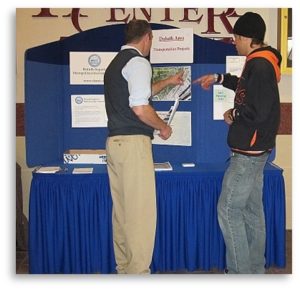 As the MPO for Duluth-Superior metro area, it’s our role to work with local jurisdictions to identify, plan for and program how federal transportation funds get used in the region.
As the MPO for Duluth-Superior metro area, it’s our role to work with local jurisdictions to identify, plan for and program how federal transportation funds get used in the region.
Since transportation projects can be big, expensive, and time-sensitive (i.e. they need to be coordinated with adjacent infrastructure projects), they need to be planned for in advance – we’re already working to line up funding for construction projects that won’t begin until four years from now.
We are part of a process that is now underway to divvy up about $40 million in federal highway transportation funds for projects throughout the Arrowhead and Northeast Minnesota for 2016.
$40 Million Might Seem Like a Lot, But…
A mile of roadway can cost almost a million bucks to repair. Now consider that the Duluth-Superior area alone has more than 350 miles of roads eligible for federal funds and, well, you get the picture. There are a lot more maintenance and construction needs than money to go around.
So, not every project can receive federal funding. That’s where the MIC’s prioritization process comes in.
Every year, jurisdictions in the Duluth metro tell us which projects they’d like to use federal funds for and we work with our Technical Advisory Committee (TAC) and Policy Board to decide which ones are the most important for meeting the current and future needs of our transportation system.
We Want to Hear from You
Road projects are a public good paid for with taxpayer money, and therefore the local citizens have a right to weigh in on such decisions, along with planners, engineers and elected officials.
This year, the following transportation projects will be prioritized for our area. All of them are intended to use your gas tax dollars to improve the region’s transportation system.
Do you have any opinions about which are more important to our area? How would you rank these proposed projects if only 2 or 3 could be chosen?
- Joshua Ave Construction – City of Duluth
- Stebner Rd Reconstruction – City of Hermantown
- Arlington Rd Resurfacing – St. Louis County
- Trunk Highway 23 Rehabilitation & Replacement of Kingsbury Creek Bridge – MnDOT
- US Highway 53 Resurfacing– MnDOT
Talk to Us – Online, In Person or by Phone
1) Make a comment, below, or
2) Stop by and visit our informational display on
- Wednesday, January 11 from 11:30 a.m. to 1:30 p.m. on the Skywalk level of the Holiday Center in downtown Duluth, or
3) Call me with questions or comments–Robert Herling at (218) 529-7573.
Although it’s only January 2012, NOW is the time to give us your input on these proposed projects before funding decisions are made for 2016. You have three ways to let us know.








